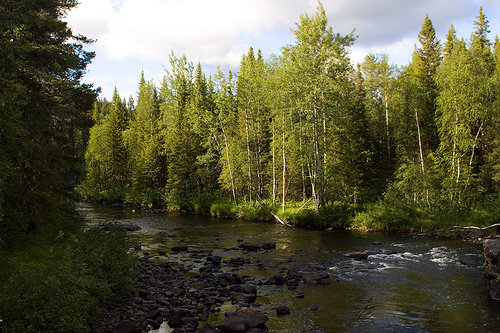

Location: Norrbotten County
Area: 493 sq km (191 sq mi)
Established: 1942
Muddus National Park (in Swedish Muddus nationalpark, in Sami Lule
Muttos) is a national park located in the municipalities of Jokkmokk
and Gällivare, in the county of Norrbotten, in the far north of
Sweden. The park was founded in 1942, but was subsequently expanded
in 1984 to cover a total of 51,137 ha. It is bordered to the
northwest by the European route 45 and the Stubba nature reserve
which provides the transition with the other natural areas of the
Lapland region.
The heart of Muddus is a vast plain at just
under 400 m above sea level, surrounded by a few small peaks at the
borders of the park, the highest of which is Sör-Stubba, rising to
665 m. In this plain develops a vast network of peat bogs, in
particular aapa peat bogs, representing almost half of the surface
of the protected area. The dry sections, meanwhile, are covered in
vast, mostly virgin taiga forest, making Muddus the largest national
forest park in the country. To the south of the park, the altitude
decreases rapidly to reach the valley of the Luleälven river. In
this section, there are several gorges, including in particular the
one formed by the main river of the park, Muttosädno, which drops 42
m at the level of the Muddusfallet waterfall.
The area has
been populated since the retreat of the glaciers around 10,000 years
ago. The inhabitants then live mainly in the valleys, but place
traps in strategic places of Muddus to capture their prey,
especially reindeer. Over time, they replaced hunting with the
domestication of reindeer, but retained their nomadic way of life,
following the reindeer herds on their annual migration. Even today,
these inhabitants, the Sami (formerly called Lapps) use the park for
reindeer herding, although the techniques and their way of life have
been modernized. Swedish colonization came later, arriving in the
park in the 19th century with the felling of the forests around its
southern border and the establishment of a farm near Lake
Muttosjávvre, active until 1909. Shortly after the formation of the
first national parks of Sweden in 1909, the vast area of primary
forests of Muddus was noticed by the forest ranger Edvard Wibeck who
then proposed, in the 1920s, to protect the site as a national park.
After a long process, the creation of this park was approved by the
Swedish parliament in 1942. Finally, in 1996, it was included in the
Lapland region World Heritage Site, thus protecting the largest
essentially intact natural area in Europe from the West, as well as
the Sami culture.
Today the site mixes reindeer herding and
tourism, with many trails in the south of the park and the
Rallarstigen in the north. About 5,000 people come each year to
admire the Muddusfallet waterfall, the deep gorge of Måskosgårsså or
watch the birds around Lake Muttosluoppal and its peat bogs thanks
to a large observation tower.